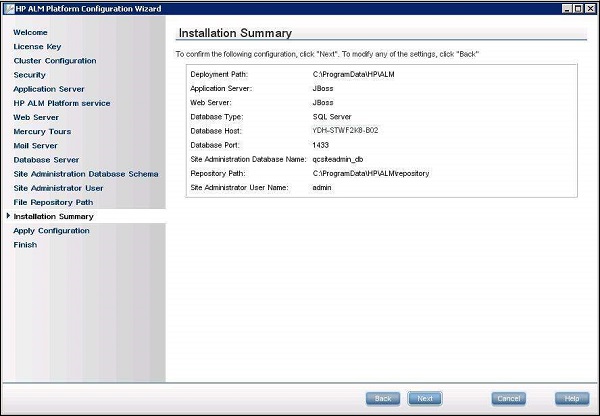Introduction:
HP Quality Center is the software quality management component of the highly renowned HP application lifecycle management (ALM) software suite. This particular system provides users with tools and applications for requirements management, quality planning, software testing management, business process testing, defect management and release and cycle management. What is Quality Center?Quality Center is a test management toolby Mercury now acquired by HPIt is a topped-up version of Mercury’s “Test Director.”Quality Center offers an organized framework for testing applications.It is a web based tool which manages all aspects of testing process which otherwise is a time. Mercury Quality Center 01:42 AM. † The opinions expressed above are the personal opinions of the authors, not of HP.
Integrating JUnit tests with HP/Mercury Quality Center Part 2: reporting annotation converage using a base class. In my previous post I talked about adding an annotation to JUnit test cases that identified corresponding manual test cases defined in Quality Center. HP Quality Center (QC), a test management tool, is now popularly known as A pplication L ife Cycle M anagement (ALM) tool, as it is no longer just a test management tool but it supports various phases of the software development life cycle. HP-ALM helps us to.
Hp Mercury Quality Center Inc
- HP quality center is web-based test management tool
- QC is used to manage the application testing process
- QC is used to define releases, specifying requirements, planning tests, executing tests, tracking defects, alerting on changes, and analyzing results
- QC also shows you how to customize your project
- Defect: Anything that is extra or missing or wrong in application is termed as defect
- QC helps you to add defects to application when found and track the defect repair progression.
- QC provides a central defect tracking system that can be used by testing and development teams to resolve defects
QC testing process includes 5 phases:
- Specifying release
- Specifying requirements
- Planning Tests
- Running Tests
- Tracking Defects
- QC Defect module provides complete system for logging, tracking, managing, and analyzing application defects
- QC Defect tracking tools are organized into: Defects grid, Grid filter, Description, Attachments, History

- In Defect module, click New Defect
- New defect dialog box contains data fields and multiple tabbed pages. This multiple tabbed pages are custom-defined by QC administrator for your project
- You can also add attachments to provide more information about the defect. QC supports five types of attachments
- Click Submit to save the defect to your project database
Hp Mercury Quality Center Software
- Use entry boxes under each field heading in grid filter to select the criteria for filtering the data in the defects grid
- Use the Filter dialog box to set a filter condition
- To clear filter criteria, click the Clear Filter/Sort button
- New: Default status when defect is reported
- Open: Indicates defect is assigned to review
- Reopen: Indicates testing team reopened the defect which was closed
- Fixed: Indicates defect is verified
- Closed: Defect is closed and waiting fro approval by tester
- Rejected: Defect is rejected , rationale fore rejecting defect to be provided
- Requirement
- Test
- Test set
- Test instance
- Test run
- Test steps
- Other Defect
- Trace your defects from perspective of QC entities
- Search defects that are related to specific QC entities
- Link multiple entities of same type to the same defect
Hp Mercury Quality Center
- Associating defects with test requirements will help to ensure consistency throughout the testing process
- The defect-requirement association enables us to utilize the status of defects to determine whether requirements have been met
- A requirement can be associated with more than one defect
- Either a existing defect can be associated with the requirement or new defect can be added to requirement

- Association of defect with test helps to ensure defect traceability throughout the testing process. A defect may be indirectly linked to a test through other entities, such as a test instance, a test run, or a test step
- Tests from Test plan module can be associated with defects that have been logged in the Defects module
- Matching defects enables you to eliminate similar and duplicate defects in your project
- Each time you add a new defect, Quality Center stores lists of keywords from the Summary and Description fields
- When you search for similar defects, keywords in these fields are matched against other defects
- Note that keywords must be more than two characters and letter case does not affect your results
Hp Mercury Quality Center Employee
Mercury And Hp Quality Center

- A defect can be regularly updated to record all the information about an issue.
- A defect can be regularly updated to record decisions made as different individuals review the defect.
- While updating the defect ,click Details to update specific data fields.
- Click Attachments to attach files to defect.
- Click Linked entities and then click the Defects tab to link a defect to another defect.
- Click Others tab to link a defect to other entities such as a test or test set.
- Click History to view the changes made to defect.
- Defect module should be displayed
- Define a filter to view defects, Click the Set Filter/Sort button. The Filter dialog box opens.
- Click the Filter Condition box, Click the browse button. The Select Filter Condition dialog box opens. Click OK to close the Select Filter Condition dialog box. Click OK to apply your chosen filter.
- Add a favorite view. In the Favorites menu, choose Add to Favorites. The Add Favorite dialog box opens.